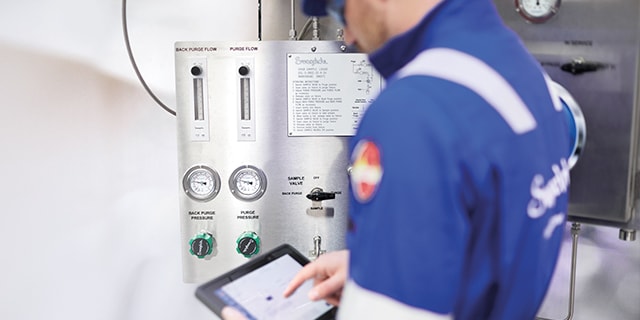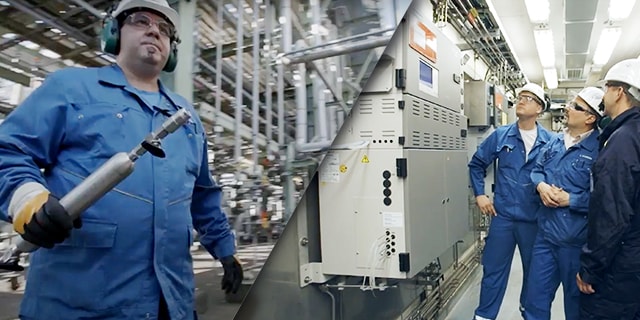Safe, Efficient, and Accurate Ammonia Sampling

How to Achieve Safer, More Accurate, and More Efficient Ammonia Sampling
Anhydrous ammonia is commonly used by chemical plants and refineries in the production of fertilizers, plastics, textiles, petroleum, and more. In these applications, ammonia must typically have a water content between 0.2% and 0.5% to prevent some potentially severe corrosion and product quality concerns. Regular testing must be performed to ensure adequate water content.
Any professional who has undertaken the task of ammonia sampling knows what this process typically entails. First, you must don the required personal protective equipment (PPE), including goggles, gloves, a respirator, and a chemical suit, to prevent exposure to ammonia vapors. Next comes the sampling process itself, a careful and exacting procedure, the results of which can be rendered inaccurate by slight missteps. Finally, the entirety of the process can take hours.
But more effective means of ammonia sampling are possible. In this article, we’ll explore why the arduous process of ammonia sampling can be a drag on efficient operation, and how a sampling system designed specifically for ammonia testing can help enhance safety, accuracy, and efficiency in your facility.
The Traditional Ammonia Sampling Method
Traditional ammonia sampling is commonly performed using the CGA G-2.2 method, where a 100 mL sample of liquid ammonia is dispensed and then allowed to evaporate. The residual water from the evaporated sample provides a reliable way to measure the ammonia’s water content, hopefully within the desired 0.2% to 0.5% range. If the water content falls outside of that range, operators should take immediate steps to correct the water content.
Water concentration below 0.2% can lead to a greater likelihood of ammonia stress corrosion cracking, and water content above the 0.5% is excessive.
Accurate measurement of water content in anhydrous ammonia is critical. If water concentration is below 0.2%, it can lead to a greater likelihood of ammonia stress corrosion cracking in storage tanks or other parts of fluid systems that regularly handle the ammonia. Stress corrosion cracking is a particularly dangerous phenomenon because it can destroy a component at stress levels below the yield strength of an alloy. While in progress, the phenomenon can be difficult to detect, and final failure can occur suddenly. Meanwhile, water content above the 0.5% threshold is excessive.
Accurate measurement using the CGA G-2.2 method is not always assured. A few variables can compromise accuracy:
- As cold ammonia fills warm glass containers, it immediately begins to boil and evaporate, making it difficult to fill residue tubes to the graduation line
- Inconsistent rates of heating can lead to inconsistency in sample results
- Inadequate flushing of residual water and old sample from the transport line can lead to samples that are not representative
This manual ammonia handling process can also be challenging to perform efficiently. It must be performed with precision to fill a warm residue tube just as ammonia boils off. Additionally, manual sampling procedures often require up to 8 hours before a measurement can be taken.
Manual sampling procedures often require up to 8 hours before a measurement can be taken.
Considering its highly toxic nature, anhydrous ammonia safety is important. The substance can cause severe skin burns, eye irritation, and it can negatively impact the environment if released into the air. This is why technicians must wear a significant amount of PPE to safely draw and test ammonia samples. They must also be exceedingly careful to avoid any spillage.
The entire process can be cumbersome, time-consuming, and prone to error. But with a properly designed sampling system specifically engineered for ammonia sampling, a better way is possible.
 A New Way to Sample Ammonia
A New Way to Sample Ammonia
Pre-engineered grab sampling systems have become a good way to achieve safe and reliable samplings of a wide variety of different industrial fluids and processes. Systems specifically designed for ammonia sampling can help improve safety by minimizing the operator’s exposure to liquid and vaporized ammonia. They can also enhance consistency while in operation and expedite the sampling process significantly. Some features to look for may include:

Closed-sample fixtures.
Closed-sample fixtures can help improve safety by limiting operator exposure and environmental impact. A closed sample design reduces the need for significant amounts of PPE. Closed fixtures may also be made of glass, allowing the operator to monitor conditions inside the system.

Effective chilling mechanisms.
Because ammonia boils off quite easily and can threaten fill accuracy, a sampling system designed with effective chilling mechanisms can help minimize the potential for excessive boiling.

Semi-automated sample dispensing.
A cap assembly can be fitted to the residue tube to assist with the filling process. When dispensing the sample, ammonia fills the residue tube until the level reaches the bottom of the overflow tube. This feature helps ensure consistent sample sizes during each use.

User-friendly operation.
Sampling systems that enable clear and simplified operation can help prevent errors and improve the user experience. For example, a geared mechanism may enable the operator to easily choose between different functions. In addition, some systems may feature an easy touch screen interface to control heater operations.

Interested in learning more about how a pre-engineered ammonia sampling system can benefit your operations? Our sampling specialists can help you decide if this kind of solution is right for your plant. Start a conversation with our team and discover how you may be able to capitalize on the benefits.
Related Articles

How to Reduce Emissions at Sampling Points
As refineries, chemical plants, and other facilities seek new ways to reduce fugitive emissions, one strategy can be relatively simply and cost-effective: specifying closed-loop sampling systems.

Analyzing Your Sampling Needs
Trying to determine whether grab sampling or online analysis is the best option to monitor your process conditions? We put together a convenient checklist to help guide you to a solution that suits your operations.

How to Safely Sample High-Viscosity Fluids in Refineries
Bitumen sampling poses some inherent challenges not found in other sampling applications. Learn some of the considerations that should be made when sampling bitumen or other high-viscosity fluids and liquids.

